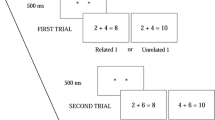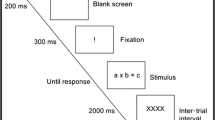Abstract
In two experiments we evaluated the coactivation of arithmetic facts and the possible inhibitory mechanism used to select the correct one. To this end, we introduced an adapted version of the negative priming paradigm in which participants received additions and they decided whether they were correct or not. When the addition was incorrect but the result was that of multiplying the operands (e.g., 2 + 4 = 8), participants took more time to respond relative to control additions with unrelated results. This finding corroborated that participants coactivated arithmetic facts of multiplications even when they were irrelevant to perform the task. Moreover, the participants were slower to respond to an addition whose result was that of multiplying the operands of the previous trial (e.g., 2 + 6 = 8). These results support the existence of an inhibitory mechanism involved in the selection of arithmetic facts.
Similar content being viewed by others
Notes
The analysis of second trial depending on the type of first trial. It is important to note that the type of second trial (multiplication 2 vs. unrelated 2) could not be analyzed depending on the type of first trial (multiplication 1 vs. unrelated 1) due to a repetition effect that might have a different impact on the two conditions of trial 2. For example, while the solution 8 is repeated in the multiplication 2 condition: 2 + 6 = 8, after the multiplication 1 condition 2 + 4 = 8; the solution 10 is repeated in the unrelated 2 condition 4 + 6 = 10 after the unrelated 1 condition 2 + 4 = 10. Note, however, that this unbalanced repetition effect is avoided when multiplication 2 and unrelated 2 conditions are directly compared since in both conditions, half of the solutions were explicitly presented in the previous trial. Nevertheless, we performed additional analyses to evaluate the influence of Trial 1 on Trial 2 by avoiding the unbalanced repetition effect. Firstly, the Trial 1 (multiplication 1, unrelated 1 condition) x Trial 2 (multiplication 2, unrelated 2) interaction was significant, F(1,47) = 17.55, p < 0.05, η 2 = 0.27. Afterward, we compared the two conditions that involved repetition: (a) multiplication 1–multiplication 2 condition vs. (b) unrelated 1–unrelated 2 condition. The RTs in Trial 2 were 100 ms slower in (a) vs. (b), F(1,47) = 6.18, p < 0.05, η 2 = 0.12, suggesting that, in spite of the repetition effect, Trial 2 was difficult to perform when it included the result of multiplying the operands of Trial 1. However, the comparison between (c) multiplication 1–unrelated 2 vs. (d) unrelated 1 vs. related 2 was not significant, F(1,47) = 2.71, p > 0.05, η 2 = 0.05 (57 ms difference). These two conditions did not involve repeating the result. Hence, the consequences of inhibiting the result of multiplying the operands of Trial 1 were only evident in Trial 2 when the result was visually present in both trials, the (a) condition.
Possible differences due to the gender of participants were examined. In Experiment 1, the results obtained in the first trial did not show differences between females and males, F(1,46) = 1.61, p > 0.05, η 2 = 0.03, and the Gender × Type of addition result was not significant F < 1. In the second trial, Gender was not a significant variable, F(1,46) = 2.35, p > 0.05, η 2 = 0.05, nor this variable interacted with type of results of previous trial, F < 1. In Experiment 2, the results of trial 1 did not show a significant effect of Gender, F < 1, and this variable did not interact with type of addition results, F < 1. In the second trial, Gender was not significant, F(1,31) = 1.12, p > 0.05, η 2 = 0.03, and this variable did not interact with type of result of previous trial, F(1,31) = 1.20, p > 0.05, η 2 = 0.04. Hence, there were no differences due to the gender of participants in this study.
References
Anderson, J. R. (1974). Retrieval of propositional information from long–term memory. Cognitive Psychology, 6, 451–474. doi:10.1016/0010-0285(74)90021-8.
Anderson, M. C. (2003). Rethinking interference theory: executive control and the mechanisms of forgetting. Journal of Memory and Language, 49, 415–445. doi:10.1016/j.jml.2003.08.006.
Anderson, M., Bjork, R., & Bjork, E. (1994). Remembering can cause forgetting: retrieval dynamics in long–term memory. Journal of Experimental Psychology. Learning, Memory, and Cognition, 20, 1063–1087. doi:10.1037/0278-7393.20.5.1063.
Arbuthnott, K., & Campbell, J. I. D. (2000). Cognitive inhibition in selection and sequential retrieval. Memory & Cognition, 28, 331–340. doi:10.3758/BF03198548.
Arbuthnott, K., & Campbell, J. I. D. (2003). The locus of self-inhibition in sequential retrieval. European Journal of Cognitive Psychology, 15, 177–194. doi:10.1080/09541440244000067.
Ashcraft, M. H. (1987). Children’s knowledge of simple arithmetic: A developmental model and simulation. In J. Bisanz, C.J. Brainerd, & R. Kail (Eds.), Formal methods in developmental psychology: Progress in cognitive development research (pp. 302–338). New York: Springer.
Ashcraft, M. H. (1992). Cognitive arithmetic: a review of data and theory. Cognition, 44, 75–106. doi:10.1016/0010-0277(92)90051-I.
Barrouillet, P., & Thevenot, C. (2013). On the problem–size effect in small additions: can we really discard any counting–based account? Cognition, 128, 35–44. doi:10.1016/j.cognition.2013.02.018.
Campbell, J. I. D., & Arbuthnott, K. (1996). Inhibitory processes in sequential retrieval: evidence from variable-lag repetition priming. Brain and Cognition, 30, 59–80. doi:10.1006/brcg.1996.0005.
Campbell, J. I. D., & Arbuthnott, K. (2010). Effects of mixing and cuing simple addition and multiplication. European Journal of Cognitive Psychology, 22, 422–442. doi:10.1080/09541440902903629.
Campbell, J., & Dowd, R. (2012). Inter–operation transfer in Chinese-English bilinguals` arithmetic. Psychonomic Bulletin & Review, 19, 948–954. doi:10.3758/s13423-012-0277-z.
Campbell, J., & Graham, D. J. (1985). Mental multiplication skill: structure, process and acquisition. Canadian Journal of Psychology, 39, 338–366. doi:10.1037/h0080065.
Campbell, J., & Thompson, V. (2012). Retrieval–induced forgetting of arithmetic facts. Journal of Experimental Psychology. Learning, Memory, and Cognition, 38, 118–129. doi:10.1037/a0025056.
Campbell, J., & Xue, Q. (2001). Cognitive arithmetic across cultures. Journal of Experimental Psychology: General, 130, 299–315. doi:10.1037/0096-3445.130.2.299.
Censabella, S., & Noël, M. P. (2004). Interference in arithmetic facts: are active suppression processes involved when performing simple mental arithmetic? Cahiers de Psychologie Cognitive, 22, 635–671.
Colomé, A., Bafalluy, M. G., & Noël, M. P. (2011). Getting to the source: a questionnaire on the learning and use of arithmetical operations. Psicológica, 32, 223–253.
Fayol, M., & Thevenot, C. (2012). The use of procedural knowledge in simple addition and subtraction problems. Cognition, 123, 392–403. doi:10.1016/j.cognition.2012.02.008.
Grabner, R. H., Ansari, D., Koschutnig, K., Reishofer, G., & Ebner, F. (2013). The function of the left angular gyrus in mental arithmetic: evidence from the associative confusion effect. Human Brain Mapping, 24, 1013–1024. doi:10.1002/hbm.21489.
Green, D. W. (1998). Mental control of the bilingual lexico–semantic system. Bilingualism: Language and Cognition, 1, 67–81. doi:10.1017/S1366728998000133.
Groen, G. J., & Parkman, J. M. (1972). A chronometric analysis of simple addition. Psychological Review, 79, 329–343.
Huber, S., Mann, A., Nuerk, H. C., & Moeller, K. (2014). Cognitive control in number magnitude processing—evidence from eye-tracking. Psychological Research, 78, 539–548. doi:10.1007/s00426-013-0504-x.
Kroll, J. F., Bobb, S. C., & Wodniecka, Z. (2006). Language selectivity is the exception, not the rule: arguments against a fixed locus of language selection in bilingual speech. Bilingualism: Language and Cognition, 9, 119–135. doi:10.1017/S1366728906002483.
LeFreve, J.-A., Sadesky, G. S., & Bisanz, J. (1996). Selection of procedures in mental addition: reassessing the problem size effect in adults. Journal of Experimental Psychology. Learning, Memory, and Cognition, 22, 216–230. doi:10.1037/0278-7393.22.1.216.
Lemaire, P., Fayol, M., & Abdi, H. (1991). Associative confusion effect in cognitive arithmetic: evidence for partially autonomous processes. Current Psychology of Cognition, 11, 587–604.
Macizo, P., Bajo, T., & Martín, M. (2010). Inhibitory processes in bilingual language comprehension: evidence from Spanish–English interlexical homographs. Journal of Memory and Language, 63, 232–244. doi:10.1016/j.jml.2010.04.002.
Macizo, P., & Herrera, A. (2011). Cognitive control in number processing: evidence from the unit–decade compatibility effect. Acta Psychologica, 136, 112–118. doi:10.1016/j.actpsy.2010.10.008.
Macizo, P., & Herrera, A. (2013). The processing of Arabic numbers is under cognitive control. Psychological Research, 77, 651–658. doi:10.1007/s00426-012-0456-6.
Radvansky, G. A., Zacks, R. T., & Hasher, L. (1996). Fact retrieval in younger and older adults: the role of mental models. Psychology and Aging, 11, 258–271. doi:10.1037/0882-7974.11.2.258.
Schneider, W., Eschman, A., & Zuccolotto, A. (2002). E–Prime user´s guide (Version 1.1). Pittsburg: Psychology Software Tools.
Siegler, R. S., & Shrager, J. (1984). Strategy choices in addition and subtraction: how do children know what to do? In C. Sophian (Ed.), Origins of cognitive skills (pp. 229–293). Hillsdale: Erlbaum.
Tipper, S. P., & Driver, J. (1988). Negative priming between pictures and words in a selective attention task: evidence for semantic processing of ignored stimuli. Memory and Cognition, 16, 64–70.
Whalen, J. (2000). The influence of semantic number representations on arithmetic fact retrieval. PhD thesis, Baltimore: Johns Hopkins University, Baltimore.
Winkelman, J. H., & Schmidt, J. (1974). Associative confusions in mental arithmetic. Journal of Experimental Psychology, 102, 734–736.
Zbrodoff, N. J., & Logan, G. D. (1986). On the autonomy of mental processes: a case study of arithmetic. Journal of Experimental Psychology, 115, 118–131.
Zbrodoff, N. J., & Logan, G. D. (2005). What everyone finds: the problem size effect. In J. I. D. Campbell (Ed.), Handbook of mathematical cognition (pp. 331–346). New York: Psychology Press.
Acknowledgments
This research was supported by the Spanish Ministry of Economy and Competitiveness (Grant PSI2012–32287) and by the Programa de Generación de Conocimiento Científico de Excelencia de la Fundación Séneca, Agencia de Ciencia y Tecnología de la Región de Murcia (research project 08741/PHCS/08). Patricia Megías is a Ph.D. candidate in Psychology (RD99/2011) at the University of Granada. We are greatly indebted to two anonymous reviewers for lots of useful theoretical and empirical comments. We thank Jamie I. D. Campbell for giving us permission upon request to use his database (Campbell & Xue, 2001) to corroborate that the additions used in the two conditions of trial 2 were equated in response latency and accuracy when individuals solve them without any manipulation.
Author information
Authors and Affiliations
Corresponding author
Rights and permissions
About this article
Cite this article
Megías, P., Macizo, P. & Herrera, A. Simple arithmetic: evidence of an inhibitory mechanism to select arithmetic facts. Psychological Research 79, 773–784 (2015). https://doi.org/10.1007/s00426-014-0603-3
Received:
Accepted:
Published:
Issue Date:
DOI: https://doi.org/10.1007/s00426-014-0603-3




